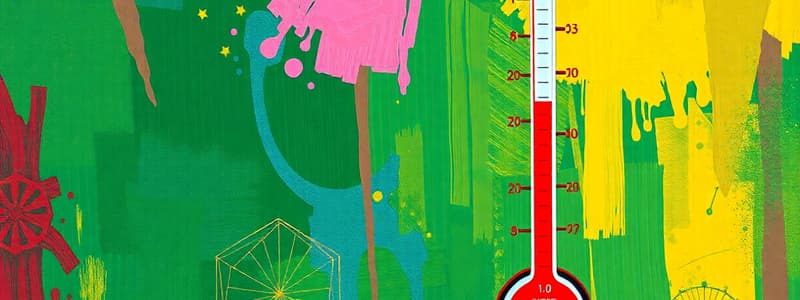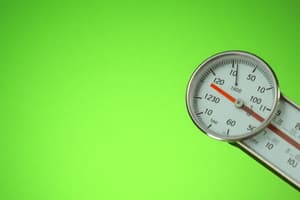Podcast
Questions and Answers
ما هي درجة تجمد الزئبق؟
ما هي درجة تجمد الزئبق؟
- -30 م
- -39 م (correct)
- 0 م
- 25 م
ما هي درجة غليان الزئبق؟
ما هي درجة غليان الزئبق؟
- 600 م
- 212 م
- 100 م
- 357 م (correct)
أي من الخصائص التالية يعتبر ميزة للزئبق كوسيلة لقياس درجة الحرارة؟
أي من الخصائص التالية يعتبر ميزة للزئبق كوسيلة لقياس درجة الحرارة؟
- يأخذ درجة حرارة الجسم بسرعة (correct)
- يفقد الحرارة بسرعة
- لا يتمدد عند التسخين
- سهل الانكسار
لماذا يعتبر الزئبق مناسباً للاستخدام في الترمومترات؟
لماذا يعتبر الزئبق مناسباً للاستخدام في الترمومترات؟
أي من الخيارات التالية يصف درجة الانصهار للزئبق بشكل صحيح؟
أي من الخيارات التالية يصف درجة الانصهار للزئبق بشكل صحيح؟
كيف يمكن تحديد درجة الحرارة المجهولة باستخدام الترمومتر البلاتيني؟
كيف يمكن تحديد درجة الحرارة المجهولة باستخدام الترمومتر البلاتيني؟
ما هو الشكل الذي يُستخدم لتحديد العلاقة بين المقاومة ودرجة الحرارة؟
ما هو الشكل الذي يُستخدم لتحديد العلاقة بين المقاومة ودرجة الحرارة؟
كيف يؤثر نوع المادة على درجة حرارة الجسم بالنسبة للطاقة الحركية للجزيئات؟
كيف يؤثر نوع المادة على درجة حرارة الجسم بالنسبة للطاقة الحركية للجزيئات؟
ما هي الخطوة الأولى لتحديد درجة حرارة وسط ما باستخدام الترمومتر؟
ما هي الخطوة الأولى لتحديد درجة حرارة وسط ما باستخدام الترمومتر؟
لماذا يعتبر الترمومتر البلاتيني مناسبًا لتحديد درجة الحرارة؟
لماذا يعتبر الترمومتر البلاتيني مناسبًا لتحديد درجة الحرارة؟
ماذا تعبر درجة حرارة جسمين لهما نفس الكتلة ولكن أنواع مختلفة؟
ماذا تعبر درجة حرارة جسمين لهما نفس الكتلة ولكن أنواع مختلفة؟
ما هي أهمية المنحنى في قياسات درجة الحرارة؟
ما هي أهمية المنحنى في قياسات درجة الحرارة؟
ما الذي يحدد ثابت التناسب في العلاقة بين درجة الحرارة والطاقة الحركية؟
ما الذي يحدد ثابت التناسب في العلاقة بين درجة الحرارة والطاقة الحركية؟
أي من العبارات التالية صحيحة حول الطاقة الحركية للأجسام المختلفة؟
أي من العبارات التالية صحيحة حول الطاقة الحركية للأجسام المختلفة؟
ما هي العلاقة بين مجموع الطاقة الحركية ودرجة الحرارة في الجسم؟
ما هي العلاقة بين مجموع الطاقة الحركية ودرجة الحرارة في الجسم؟
ماذا يحدث عندما تنخفض درجة حرارة الحمام؟
ماذا يحدث عندما تنخفض درجة حرارة الحمام؟
كيف يساهم انخفاض درجة حرارة الحمام في عملية التحكم في الحرارة؟
كيف يساهم انخفاض درجة حرارة الحمام في عملية التحكم في الحرارة؟
ما الذي يحدث لمستوى الزئبق عندما ينكمش السائل؟
ما الذي يحدث لمستوى الزئبق عندما ينكمش السائل؟
ما الذي يسمح بمرور الغاز مرة أخرى في المسار المحدد؟
ما الذي يسمح بمرور الغاز مرة أخرى في المسار المحدد؟
ما هي نتيجة السماح بمرور الغاز في المسار المذكور؟
ما هي نتيجة السماح بمرور الغاز في المسار المذكور؟
ما هي المادة المستخدمة في أسلاك التوصيل للإزدواج الحراري في الحالة العادية؟
ما هي المادة المستخدمة في أسلاك التوصيل للإزدواج الحراري في الحالة العادية؟
ما هو الشكل الذي يوضح طريقة توصيل الإزدواج الحراري عندما يكون المعدن B غير النحاس؟
ما هو الشكل الذي يوضح طريقة توصيل الإزدواج الحراري عندما يكون المعدن B غير النحاس؟
ماذا يحدث في الشكل (۱۰) بالنسبة لنقاط الاتصال بين المعدنين A و B والنحاس؟
ماذا يحدث في الشكل (۱۰) بالنسبة لنقاط الاتصال بين المعدنين A و B والنحاس؟
ما هي الوظيفة الرئيسية للإزدواج الحراري في هذه الحالة؟
ما هي الوظيفة الرئيسية للإزدواج الحراري في هذه الحالة؟
ما هي أهمية تعديل طريقة توصيل الإزدواج الحراري عند استخدام معدن غير النحاس؟
ما هي أهمية تعديل طريقة توصيل الإزدواج الحراري عند استخدام معدن غير النحاس؟
ماذا يحدث عند مرور تيار كهربائي في فتيلة المصباح؟
ماذا يحدث عند مرور تيار كهربائي في فتيلة المصباح؟
كيف يتم ضبط شدة التيار في التجربة؟
كيف يتم ضبط شدة التيار في التجربة؟
ماذا يحدث عندما تصبح شدة التيار متساوية بين الفتيلة وصورة الفرن؟
ماذا يحدث عندما تصبح شدة التيار متساوية بين الفتيلة وصورة الفرن؟
كيف تؤثر شدة التيار على صورة الفتيلة مقارنة بصورة الفرن؟
كيف تؤثر شدة التيار على صورة الفتيلة مقارنة بصورة الفرن؟
ماذا يمكن أن يحدث عند تقليل شدة التيار عن المطلوب؟
ماذا يمكن أن يحدث عند تقليل شدة التيار عن المطلوب؟
Flashcards
درجة حرارة الجسم
درجة حرارة الجسم
تُعبر عن مُستوى الطاقة الحركية لِجزيئات الجسم.
العلاقة بين درجة الحرارة والطاقة الحركية
العلاقة بين درجة الحرارة والطاقة الحركية
تتناسب درجة الحرارة طرديًا مع مجموع الطاقة الحركية للجزيئات.
ثُبات التناسب (ثابت التناسب)
ثُبات التناسب (ثابت التناسب)
يختلف من مادة لأخرى، وباختلاف كتلة الأجسام.
جسمين متساويي الحرارة
جسمين متساويي الحرارة
Signup and view all the flashcards
تساوي كتلة الجسمين
تساوي كتلة الجسمين
Signup and view all the flashcards
درجة غليان مرتفعة
درجة غليان مرتفعة
Signup and view all the flashcards
درجة انصهار منخفضة
درجة انصهار منخفضة
Signup and view all the flashcards
زئبق
زئبق
Signup and view all the flashcards
نقاء الزئبق
نقاء الزئبق
Signup and view all the flashcards
استخدام الزئبق في الترمومتر
استخدام الزئبق في الترمومتر
Signup and view all the flashcards
العلاقة بين المقاومة ودرجة الحرارة
العلاقة بين المقاومة ودرجة الحرارة
Signup and view all the flashcards
طريقة تعيين درجة الحرارة
طريقة تعيين درجة الحرارة
Signup and view all the flashcards
الترمومتر البلاتيني
الترمومتر البلاتيني
Signup and view all the flashcards
المنحنى (شكل 3)
المنحنى (شكل 3)
Signup and view all the flashcards
قياس درجة الحرارة المجهولة
قياس درجة الحرارة المجهولة
Signup and view all the flashcards
صورة الفرن الحمراء
صورة الفرن الحمراء
Signup and view all the flashcards
تسخين الفتيلة
تسخين الفتيلة
Signup and view all the flashcards
صورة الفتيلة
صورة الفتيلة
Signup and view all the flashcards
شدة التيار
شدة التيار
Signup and view all the flashcards
تطابق شدة التيار
تطابق شدة التيار
Signup and view all the flashcards
قياس درجات حرارة منخفضة/مرتفعة
قياس درجات حرارة منخفضة/مرتفعة
Signup and view all the flashcards
توصيل الإزدواج الحراري
توصيل الإزدواج الحراري
Signup and view all the flashcards
معدن غير النحاس
معدن غير النحاس
Signup and view all the flashcards
نقطتي اتصال المعدنين
نقطتي اتصال المعدنين
Signup and view all the flashcards
شكل (10)
شكل (10)
Signup and view all the flashcards
انخفاض درجة حرارة الحمام
انخفاض درجة حرارة الحمام
Signup and view all the flashcards
انكماش السائل
انكماش السائل
Signup and view all the flashcards
انخفاض مستوى الزئبق (في الترمومتر)
انخفاض مستوى الزئبق (في الترمومتر)
Signup and view all the flashcards
مرور الغاز في المسار
مرور الغاز في المسار
Signup and view all the flashcards
ثبات درجة حرارة الحمام
ثبات درجة حرارة الحمام
Signup and view all the flashcards
Study Notes
Introduction to Heat
- This document is on the topic of heat, specifically focusing on temperature measurement and its practical applications.
- It covers different methods of measuring temperature using various types of thermometers.
- The study explores the theoretical foundation behind temperature and heat transfer.
Temperature and Measurement
- Temperature is a measure of the average kinetic energy of the molecules in a substance.
- Higher temperature equates to increased kinetic energy of the molecules.
- Temperature doesn't directly measure the total kinetic energy; it indicates the average energy level.
- Temperature is measured by comparing the heat levels of two objects, where one object's temperature is known.
- Different physical properties of materials change with temperature (e.g., electrical resistance, gas pressure at constant volume, liquid column length in a capillary tube).
- Thermometers are devices built on these temperature-dependent material properties.
Types of Thermometers
- Liquid-in-glass thermometers: These use the expansion of a liquid (like mercury or alcohol) in a narrow tube. The liquid expands at a specific rate with temperature change.
- Key qualities for liquid thermometers:
- The liquid must be opaque for easy reading.
- The liquid should be a good thermal conductor for rapid temperature measurement.
- High expansion rate for significant liquid level changes with temperature changes.
- Low specific heat and density for minimizing heat absorption from the subject.
- High boiling point and low freezing point are essential.
- Gas thermometers: Use the change in volume of a gas at constant pressure (or change in pressure at constant volume). Gas thermometers are accurate and suitable for a wide range of temperatures.
- Resistance thermometers: These measure temperature through the change in electrical resistance of a material (like platinum). Platinum is preferred because the relationship between resistance and temperature is nearly linear over a broader range.
- Thermocouples: These utilize the Seebeck effect, where a voltage difference arises when two dissimilar metals are joined and exposed to a temperature difference. Thermocouples are frequently used for high or low temperatures.
Temperature Scales
- The Celsius scale uses the freezing point of water (0°C) and the boiling point (100°C) as reference points.
- The Fahrenheit scale uses 32°F for freezing and 212°F for boiling.
- The Kelvin scale has absolute zero as its starting point.
Further Considerations
- Accuracy and sensitivity are critical properties of any thermometer. A change in temperature should result in a significant change in the measuring device.
- Important points:
- Gas thermometers are often considered the standard when precision is required due to the consistent relationship between volume and temperature.
- Gas thermometers may be complex to set up but offer wide and repeatable measurements.
- Thermocouples are well suited for high and low-temperature measurements and rapid temperature changes.
- Important Concepts:
- The study discusses how to calibrate various temperature measurement devices based on the selected points of reference and how to construct the required linear relationship.
Studying That Suits You
Use AI to generate personalized quizzes and flashcards to suit your learning preferences.




